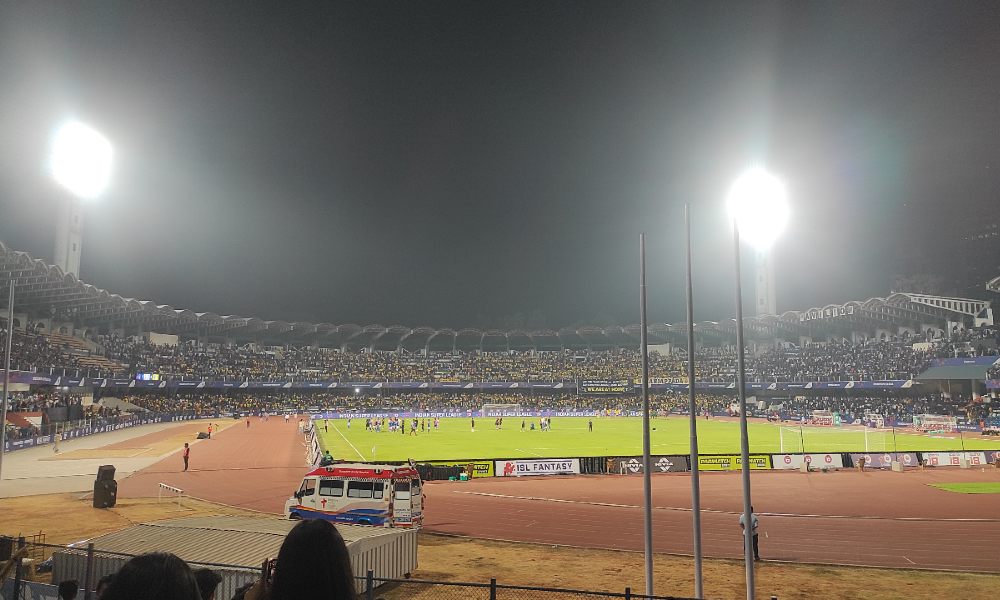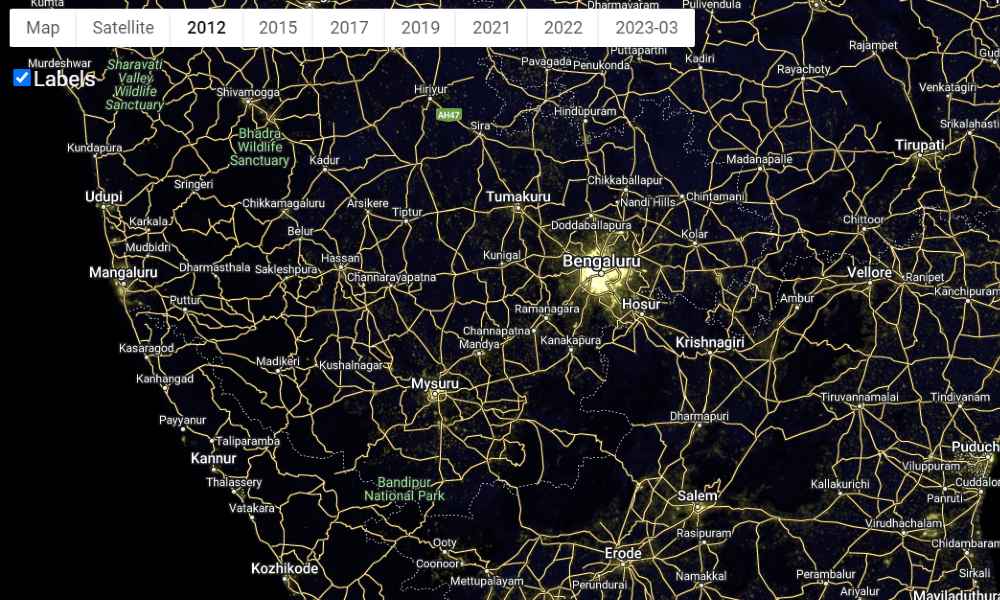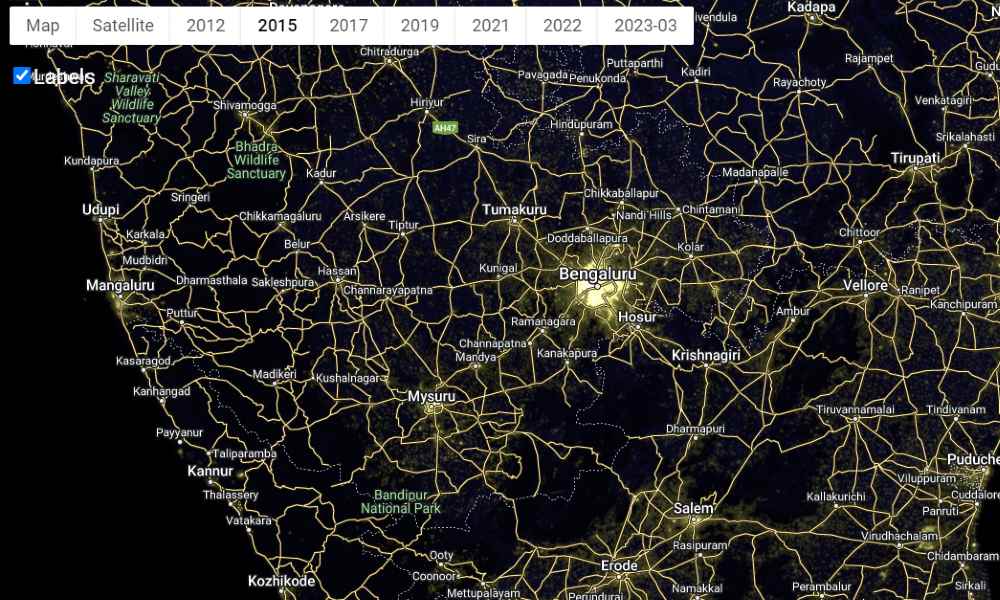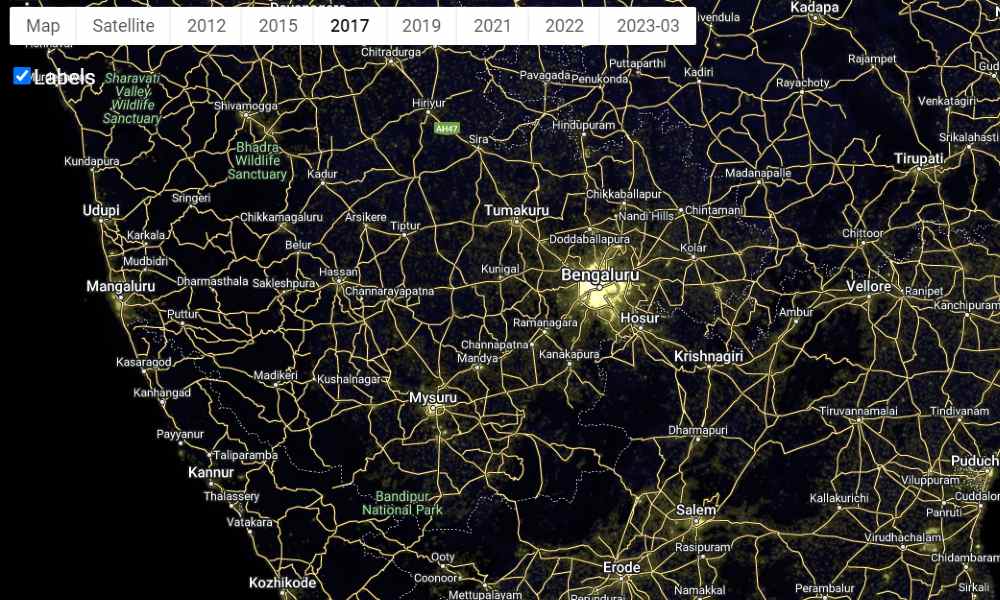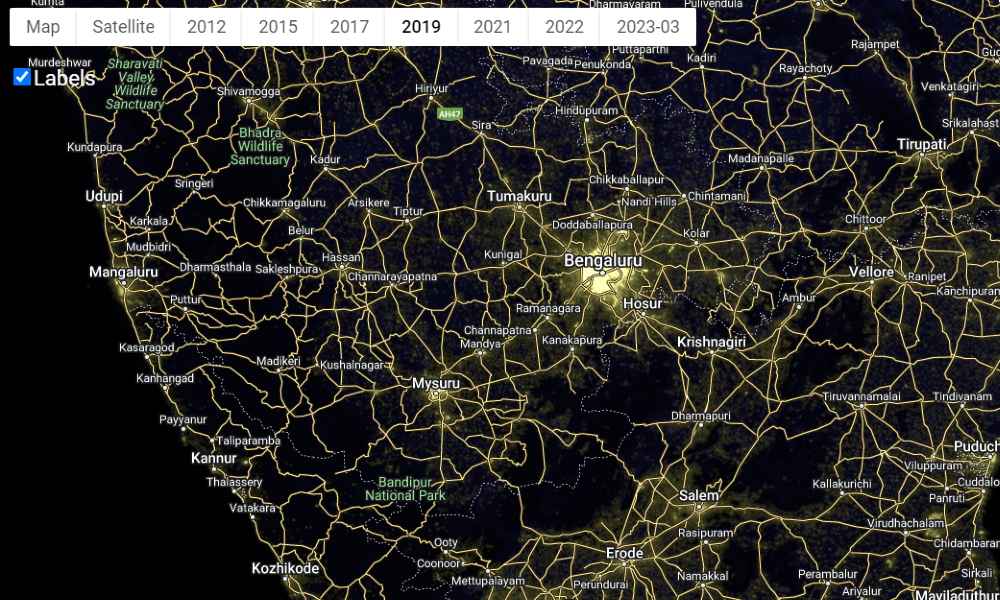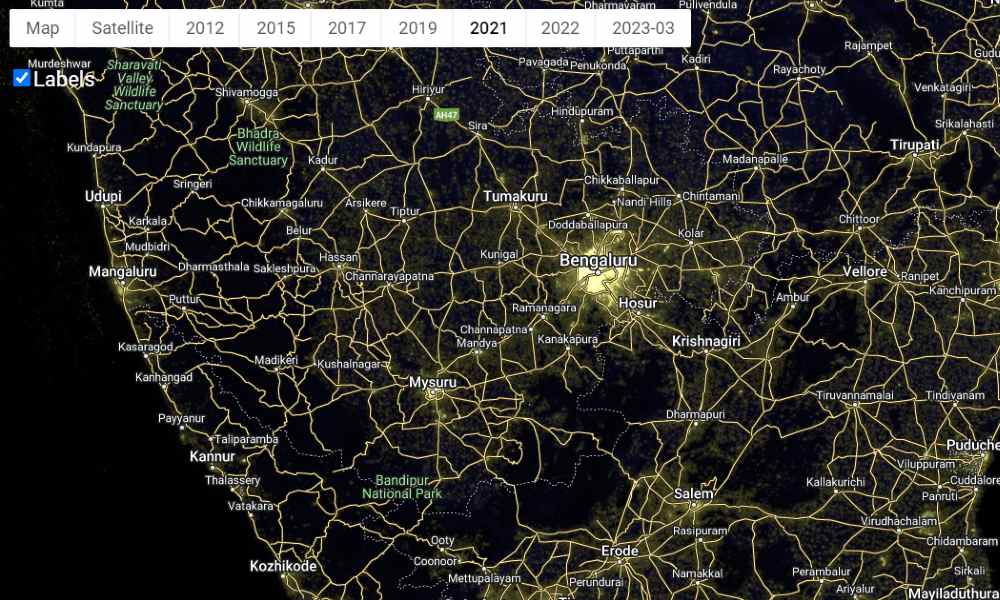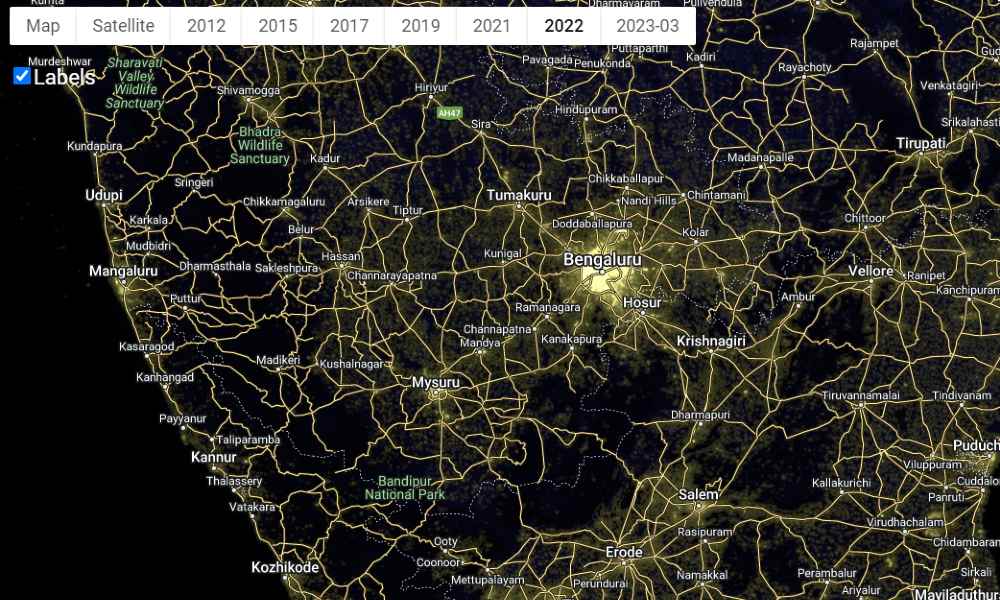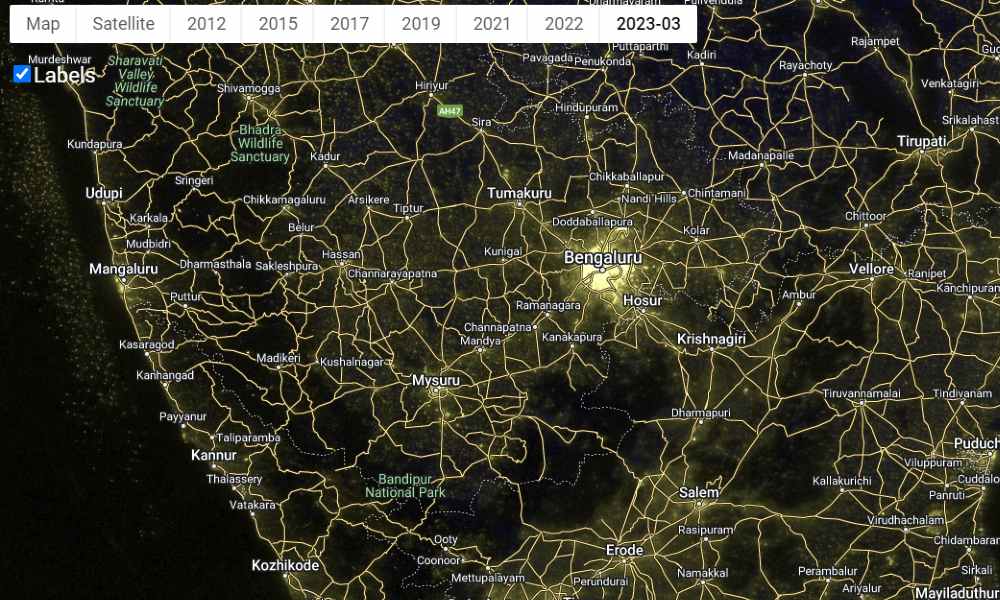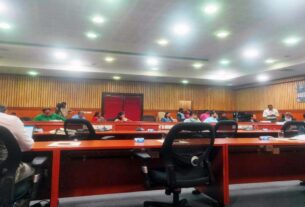Studies show that Bangalore is the third light-polluted city in India after Delhi and Hyderabad.
Krithika, a middle-aged graphic designer in Bangalore, vividly remembers her childhood days, when she used to enjoy her way back home from tuition class marvelling at the star-filled night sky. It has been years since she witnessed something similar. She is concerned over the fact that her children would never get to see the night sky in its full magnificence.
Not just Krithika, many in the city, including amateur astronomers, shared similar concerns. Reduced visibility of the night sky is one of the most evident impacts of light pollution. However studies from around the world show that excessive or inappropriate use of outdoor artificial light affects the environment, human health, wildlife behaviour and migration patterns.
According to a study by DarkSky International, more than 80 per cent of the world’s population lives under light-polluted skies.
Indian cities, like Bangalore have been experiencing increased exposure to light pollution. Night-lights map by Blue Marble Navigator of National Aeronautics and Space Administration (NASA) indicates that Bangalore has witnessed a steady rise in light pollution over the years.
According to a 2021 study on light pollution Bangalore is third among the cities with the maximum area under light pollution in the country. Similarly a 2019 study notes that the brightness from outdoor lights has been on a steady rise in various parts of India from 1993-2013. Karnataka was noted to have experienced an increase in “very high light pollution intensity” in this period.
Experts mention that urbanization and changes in lifestyles have resulted in increased use of various kinds of lighting systems in the cities. Kshama Puntambekar, Assistant Professor, Department of Urban and Regional Planning at the School of Planning and Architecture (SPA), Bhopal, and author of the 2021 report said, “The night time image of a city represents the city’s development and therefore its need for more light.” She said that for a city where a lot of activities are carried out after sunset full-time availability of light is essential. Similarly, streetlights on roads and highways are necessary to ensure the safety of residents.
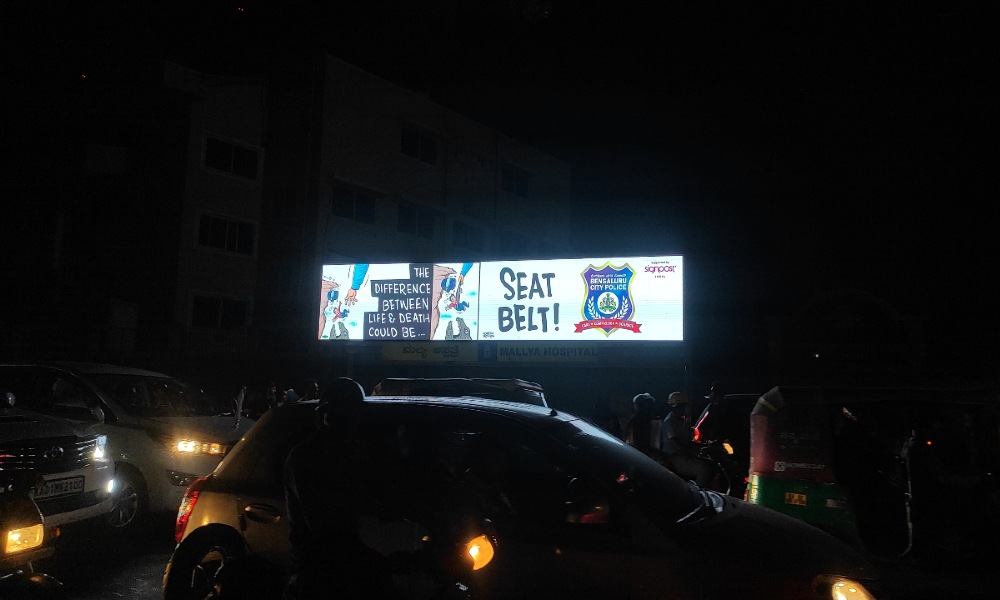
Amateur astronomers and sky observers in the city complain about having to travel more than 60 kilometres to darker locations outside the city for stargazing. Suresh Randadath, amateur astronomer and environment conservationist, shared his concern over the reduced visibility of the night sky due to excessive light projecting upwards. He said that he has to travel around 300 kilometres from Bangalore to remote areas in Coorg to observe the night sky. “We can see so many stars there, while in the city you can barely see some 100 stars,” he complained.
Rama Krishna, an Amateur Astronomer and Precision Optics Manufacturer at the India Astronomy Club (IAC) in Bangalore, said that thirty years ago, one could observe the Milky Way from places close to Whitefield and the HSR layout. However, nowadays, these dark spots have moved even farther from the city’s outskirts.
Niraj Mohan R, Scientist at the Indian Institute of Astrophysics (IIA) and member of the Astronomical Society of India said that observatories around the world are affected by the increasing light pollution as well as theirs.. The observatories were built in relatively uninhabited locations or near small villages. With the development of villages and cities around, all observatories except those in remote areas are affected, he added.
He further said, “Children in major cities like Mumbai, Delhi, and Bangalore learn about the night sky from textbooks, photographs and videos on their monitors, but would have never seen the Milky Way or even the constellations.”
However, it has many adverse effects on the environment as well as life on Earth. Subiksha Venkatesh, Rescue Manager at the Avian and Reptile Rehabilitation Centre (ARRC), pointed out the disruption caused by overexposure to light in the behaviours of diurnal birds such as kites and crows. “Instead of resting at night, they remain active, especially around areas with nightlife and sports stadiums,” she said. She also observed an increase in the number of birds like the Indian Pitta colliding with illuminated windows.
Similarly, Arijit Pal, Postdoctoral Associate, Animal Behaviour and Cognition Programme at the National Institute of Advanced Studies (NIAS)observed that light pollution has a major impact on the flora and fauna in Bangalore, as the city is close to forest ranges. He mentioned that the number of wild plants and animals found in the small green patches within the city is declining. He further added that artificial light has led to disruption in foraging and mating of nocturnal animals like Loris, a primate, found in some green patches of the city.
Many species are found to be adapting to the changed environment. Arjit noted that birds like Bulbul, are now found to be sitting on lamp posts and feeding on insects coming across the lamp. Similarly, toads are found sitting under the lamppost and foraging from there. However, he maintains that adaptation of species does not indicate their survival.
Light pollution is also linked to an increased risk of health problems in humans. According to a 2023, study, the introduction of artificial lights had a significant impact on human health such as sleep disturbance, and depression.
What next
Shops must avoid keeping illuminated boards after 10 pm, suggested Mr. Niruj. He further suggested reducing the use of high-beam lights in vehicles that also lead to road accidents.
Experts suggest the optimal use of lighting in corporate buildings, housing, and advertisement boards. Mr Randadath suggested the installation of motion sensor lights in streets to prevent them from being lit throughout the night. He further advocates government action to ensure that light fixtures are pointing downwards.
However, Prof. Puntambekar maintains that there is no one point solution to the problem. Studies have to be done to identify what is harmful and actions have to be taken accordingly, she added.
Experts say that there has been an increased awareness of pollution in the global community over the years. The Conference of the Parties to the Convention on the Conservation of Migratory Species of Wild Animals (CMS COP14) held in Uzbekistan, on February 2024, prepared ‘International Light Pollution Guidelines for migratory species,’ to minimize its effect on wildlife. The conference noted that natural darkness has a conservation value equal to clean water, air, and soil.
Many organisations like the International Dark Sky Association (IDA) have been working towards reducing light pollution. On January 11, 2024, the Pench Tiger Reserve (PTR) in Maharashtra was declared as India’s first International Dark Sky Park, and fifth such park in Asia by the IDA, for protecting the night sky and preventing light pollution.

